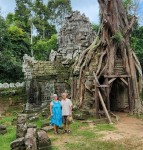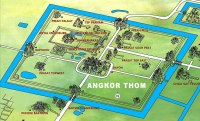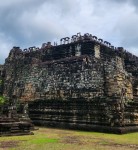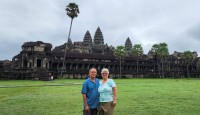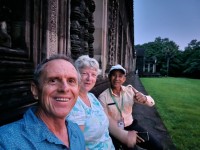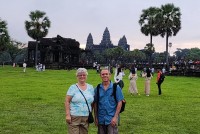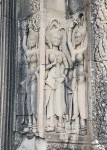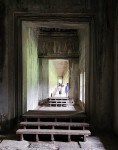Saturday, September 23, Day 2, Grand or Large Circuit, Equinox
 Breakfast was included with our room and it was a large buffet with a mix of European, American, and Asian foods as the hotel has a diverse international clientele. Mr. Nara met us in the lobby at 8 and he double checked that we had our Angkor Pass with us. They not only check it when you drive into the Angkor Complex on the road but they look at it at each temple as you enter. Mr. Thom was our driver again.
Breakfast was included with our room and it was a large buffet with a mix of European, American, and Asian foods as the hotel has a diverse international clientele. Mr. Nara met us in the lobby at 8 and he double checked that we had our Angkor Pass with us. They not only check it when you drive into the Angkor Complex on the road but they look at it at each temple as you enter. Mr. Thom was our driver again.
 Our plan for the day was to follow what they term the grand or large circuit because it goes in a larger circle around the tight grouping of temples we visited the first day known as the small circuit. We requested two additions: the first was to visit the third floor of Angkor Wat because it had been closed to the public yesterday. And we asked to visit a temple we had read was a small hidden gem that is right outside the Victory Gate.
Our plan for the day was to follow what they term the grand or large circuit because it goes in a larger circle around the tight grouping of temples we visited the first day known as the small circuit. We requested two additions: the first was to visit the third floor of Angkor Wat because it had been closed to the public yesterday. And we asked to visit a temple we had read was a small hidden gem that is right outside the Victory Gate.
 We started with the Angkor Wat third floor visit, entering the grounds by crossing the moat from the East over a “temporary” dirt road causeway that was created by the French when they were working on restoration decades ago. They built the causeway as a way to get heavy equipment and supplies into the temple complex without damaging anything of historical value. The third floor contains the central tower and is anchored on all four corners by the next four tallest towers. The five towers represent the peaks of Mount Meru. It was exclusively for spiritual use by the king and queen. The center tower has buddhas in all four nooks and monks actively providing blessings.
We started with the Angkor Wat third floor visit, entering the grounds by crossing the moat from the East over a “temporary” dirt road causeway that was created by the French when they were working on restoration decades ago. They built the causeway as a way to get heavy equipment and supplies into the temple complex without damaging anything of historical value. The third floor contains the central tower and is anchored on all four corners by the next four tallest towers. The five towers represent the peaks of Mount Meru. It was exclusively for spiritual use by the king and queen. The center tower has buddhas in all four nooks and monks actively providing blessings.  Magnificent views can be seen from the third floor tower windows and Neil got great photos. Neil requested we visit the Buddha on the first floor again and Mr. Nara took us downstairs and this time he had us sit and remove our shoes to show our respect.
Magnificent views can be seen from the third floor tower windows and Neil got great photos. Neil requested we visit the Buddha on the first floor again and Mr. Nara took us downstairs and this time he had us sit and remove our shoes to show our respect.  Once again the energy and blessings flowed to us in meditation and I felt the peace to all humanity to end war moving out from this spot and spreading around the world. That is the vision I hold every day for world peace. Neil was overcome with a similar vision: compassion and forgiveness and healing peace spreading across the globe. We shared this with Mr. Nara and we think we continued to blow him away.
Once again the energy and blessings flowed to us in meditation and I felt the peace to all humanity to end war moving out from this spot and spreading around the world. That is the vision I hold every day for world peace. Neil was overcome with a similar vision: compassion and forgiveness and healing peace spreading across the globe. We shared this with Mr. Nara and we think we continued to blow him away.
Exiting from the back East entrance, we paused to view more bas-relief carvings. This East gallery wall depicts the story of the Churning of the Ocean of Milk.
We stopped at so many temples on our tour, I am only going to say a few words about our impressions and you can follow the links for more information on each. There are a lot more photos of the two of us together because our guide was enthusiastic about taking our photo at multiple stops.
Ou r next stop was at Pre Rup which was a Hindu temple built in the early years when they were using brick for their structures and stone for carvings. The carvings are still clear in much of the stone work. Pre Rup was built to be a duplicate but more accessible version of
r next stop was at Pre Rup which was a Hindu temple built in the early years when they were using brick for their structures and stone for carvings. The carvings are still clear in much of the stone work. Pre Rup was built to be a duplicate but more accessible version of  East Mebon which was built on an island in a reservoir 3 km by 7 km! Temple-goers had to take a ferry about 1.5 km (more than a mile!) in order to visit and the time and expense were inconvenient for most commoners. Just pause for a moment and imagine the vast scope of what we were seeing, of what these people built and how magnificent it must have been back in its day. The reservoir wall was breached centuries later and the water has since mostly drained but it was said that since not all people were able to access the island temple, the king built Pre Rup on land so more worshipers would be able to access it.
East Mebon which was built on an island in a reservoir 3 km by 7 km! Temple-goers had to take a ferry about 1.5 km (more than a mile!) in order to visit and the time and expense were inconvenient for most commoners. Just pause for a moment and imagine the vast scope of what we were seeing, of what these people built and how magnificent it must have been back in its day. The reservoir wall was breached centuries later and the water has since mostly drained but it was said that since not all people were able to access the island temple, the king built Pre Rup on land so more worshipers would be able to access it.  East Mebon has a large base of stones that were originally below water level. There are elephant sculptures at each corner that were carved out of a single block of stone. Someone earlier that morning had left a fresh offering of sugarcane at each one.
East Mebon has a large base of stones that were originally below water level. There are elephant sculptures at each corner that were carved out of a single block of stone. Someone earlier that morning had left a fresh offering of sugarcane at each one.
 Ta Som was built to honor the king’s sister, according to Mr. Nara. It was one of the loveliest temples I saw. It was also unique in that it has a double moat. Mr. Nara explained the moats had an important function beyond what you would think of as protection, they were to keep the ground under the temples with the right amount of moisture to support the heavy stone structures of the temples.
Ta Som was built to honor the king’s sister, according to Mr. Nara. It was one of the loveliest temples I saw. It was also unique in that it has a double moat. Mr. Nara explained the moats had an important function beyond what you would think of as protection, they were to keep the ground under the temples with the right amount of moisture to support the heavy stone structures of the temples. 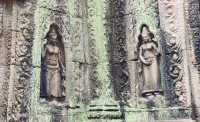 Too little or too much water would cause the heavy stones to sink and become unstable.
Too little or too much water would cause the heavy stones to sink and become unstable.
Mr. Nara often referenced the number of hospitals the kings had established around the county for the people (more than 100). The kings really did care for their people, building schools, libraries, hospitals, and roadways.  Neak Poan was one of these hospitals or healing temples. Today, we would call it a healing center or clinic because they did not stay in rooms or beds for extended periods of time like we are accustomed to. It has been well restored. The people would be diagnosed and treated by the resident healers, they would be given medicinal herbs and whatever else they needed, and they and accompanying family members would be reimbursed for their travel expenses to get there and home.
Neak Poan was one of these hospitals or healing temples. Today, we would call it a healing center or clinic because they did not stay in rooms or beds for extended periods of time like we are accustomed to. It has been well restored. The people would be diagnosed and treated by the resident healers, they would be given medicinal herbs and whatever else they needed, and they and accompanying family members would be reimbursed for their travel expenses to get there and home.
 Re-crossing the moat we could see dark clouds and a heavy cloudburst rapidly approaching. We hurried and got under cover at a wall-less open air restaurant for lunch just as the heavy downpour swept over the area. Even the wild chickens and stray cats ran into the shelter of the restaurant shaking water off their feathers and fur. There was a momentary interspecies truce as we all watched the sheets of rain. The rain mostly ended by the time we finished lunch and from our sheltered seats in Mr. Thom’s tuk tuk we bought cheap plastic raincoats from a happy stall keeper just in case.
Re-crossing the moat we could see dark clouds and a heavy cloudburst rapidly approaching. We hurried and got under cover at a wall-less open air restaurant for lunch just as the heavy downpour swept over the area. Even the wild chickens and stray cats ran into the shelter of the restaurant shaking water off their feathers and fur. There was a momentary interspecies truce as we all watched the sheets of rain. The rain mostly ended by the time we finished lunch and from our sheltered seats in Mr. Thom’s tuk tuk we bought cheap plastic raincoats from a happy stall keeper just in case.
Preah Khan temple was built to honor the king’s father. The temple is huge with what was once tightly packed towers. There are piles of stones around but enough has been restored to give the impression of the impressive temple that it once was.
 Chau Say Tevada was the small gem temple that Neil had read about and wanted to see. The entrance and temple building is partially restored and the grounds are cleared of excess stones and it is a picturesque temple. Immediately across the road is another small temple: the Thommamon temple.
Chau Say Tevada was the small gem temple that Neil had read about and wanted to see. The entrance and temple building is partially restored and the grounds are cleared of excess stones and it is a picturesque temple. Immediately across the road is another small temple: the Thommamon temple.  We read later that this is one of the most restored temples, at least on the exterior as they often hold official dinners here in the courtyard with the temple as the picturesque backdrop.
We read later that this is one of the most restored temples, at least on the exterior as they often hold official dinners here in the courtyard with the temple as the picturesque backdrop.
It had been another long day for all of us. Neil and I had a little down time and then headed out on foot to dinner. I had seen a restaurant that was within walking distance that was well lit and always busy. We heard it was a “noodle shop” and walked there for our evening meal. It was a cook-your-own soup at your table kind of family restaurant and we were the only tourists in the place. One of the waitresses had enough English to say they only served the one thing and we nodded that was fine.  They brought a broth base in a pan they set on the burner at the table and then several little plates from which you can choose what to put in your pot. Noticing we were clueless, she came to help us and we put everything in and let it cook and put it on simmer. She later checked and we weren’t eating. I said we didn’t have any utensils and she ran off to get us bowls, spoons, and ladles. It was a really fun experience.
They brought a broth base in a pan they set on the burner at the table and then several little plates from which you can choose what to put in your pot. Noticing we were clueless, she came to help us and we put everything in and let it cook and put it on simmer. She later checked and we weren’t eating. I said we didn’t have any utensils and she ran off to get us bowls, spoons, and ladles. It was a really fun experience.















































